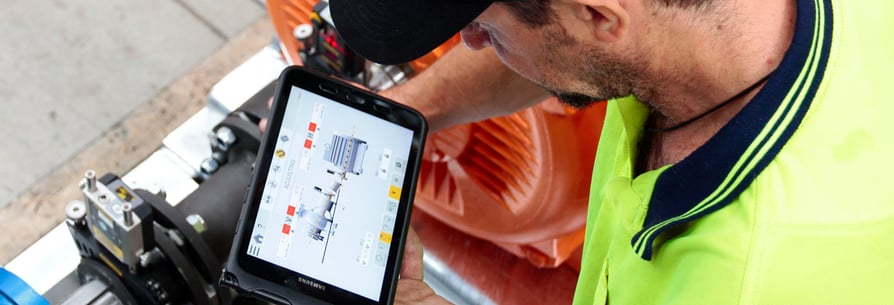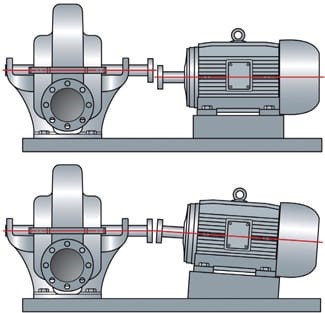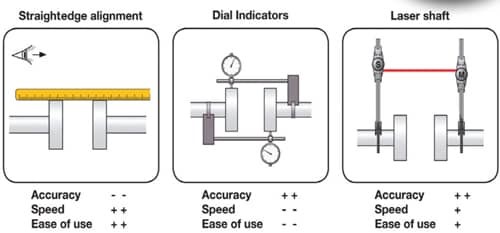With operators constantly looking to achieve efficiency gains and extend the service life of their pumps, the issue of correct pump shaft alignment should be one of the first places to look for savings. An incorrectly aligned shaft can lead to premature bearing failures as well as increasing power draw and costing more to run. With these in mind, let's look at how we align a shaft, and what level of pump misalignment is acceptable.

Pump and motor shaft alignment
Firstly, a pump works by transferring the rotation from a motor, through a coupling into the pump shaft, which then spins an impeller and allows the fluid to be moved. We want to ensure that the pump shaft and motor shaft are as closely aligned as possible. We can experience misalignment in both vertical and horizontal planes, as well as angular misalignment in each of the planes. Refer to the below image for a visual representation of this.

Running a pump with misaligned shafts causes undue strain on the bearings of both the pump and motor, as well as causing vibrations that can rapidly cause seal failure.
Types of pump misalignment:
Pumps can either be installed misaligned, or gradually become misaligned over time. There is a common fallacy within the industry that when we align a pump in the factory that you don’t need to realign it at installation. This is so incredibly untrue and the cause for very rapid pump failure and heartache on site. While a pump skid may look big and robust, the base will bend and move with incredible ease. The motor may also be knocked out of place during installation. With this in mind, you must ALWAYS align a pump onsite, AFTER installing all the pipework.
Pumps can also grow to become misaligned. This may be due to changes in the pipework, ground subsidence, vibration or a multitude of other factors. This is why periodically the maintenance team needs to be given time and access to align the pumps on site.
How to detect pump misalignment:
While the pump is in operation, there are 2 methods of determining if the pump is misaligned, or progressively becoming misaligned. The first is wear and bearing/seal failures. This method is far from scientific, the operator will recognize that a bearing, particularly the Drive end bearing has failed prematurely and will hopefully suggest checking the shaft alignment. The other more scientific method which all sites should be using, is vibration analysis. By using a vibration analysis meter, the operator can look at the vibration that is occurring in the bearings and we can determine by looking at the frequency of those vibrations what would be causing the issue. Each vibration pattern is unique to a common issue such as bearing failure, misalignment, cavitation etc.
How to align a pump:
There are 3 different pump shaft alignment tools that we can use to carry out a shaft alignment. The least effective is a straight edge and feelers. This is useful for very rapid checks to see if the equipment is “close” to being aligned. We check both planes of alignment and move the motor to get them with an even gap on both sides.
The next best method is using 2 Dial Indicators. For many years, this was the go to method of accurate shaft alignment. To use this method, we clamp a dial indicator onto the shaft of the motor, then run the measuring pin on the coupling on the pump. As we rotate the motor, the pin will move up and down showing where the high and low areas are in both planes. We can also use this method to check for angular misalignment by moving the dial indicator pin to the faces of the coupling. This method is extremely accurate, but can be very time consuming for inexperienced operators and lead to a lot of re-work if they don’t know how to adjust for the readings.
The last and most effective method is pump laser alignment. Laser alignment for pumps works by clamping a laser on one shaft, and the mirror on the other. Then both shafts are rotated together and the inbuilt computer will tell the operators what adjustments are needed to bring the pump into alignment. For most sites, a laser alignment is the only method they will use and accept.

Order of alignment:
As previously discussed, we have 4 separate alignment variables, vertical, horizontal and the angular alignment of each of those planes. The order in which we correct these alignments is important to avoid re-work.
The vertical angular alignment is always the first correction. This ensures that the motor is sitting at least parallel to the pump. To correct, we may need to put shims on either the front or back foot to get a parallel reading.
Next we tackle Vertical alignments. This adjustment is always before horizontal, as you are going to need to physically lift the motor to adjust shims. If you were to do horizontal first, then you would need to redo that after you’d adjusted for Vertical alignment.
Now that we have the pump and motor at the same height, we can use our jacking bolts to nudge the motor around in the horizontal plane to ensure that its both parallel and concentric to the pump shaft.
Key points for beginners:
- When taking a measurement, it's always done AFTER the bolts have been tightened, as the act of tightening the bolts can cause the motor to move again.
- Always ensure the pipework has been installed and tightened before aligning the pump. The pipework can cause the pump to move on installation.
- Jacking bolts will always be removed or loosened after the pump is aligned.
- IF a pump runs with hot fluid, always re-align it immediately after running, as the pump may grow through thermal growth to be out of alignment.
- Always ensure the pump base is secured and grouted in before alignment, as the base can warp and wreck a good alignment.
How close is close enough:
Installers often read a coupling specification and assume that because a couple CAN handle 2-3mm of misalignment, they shouldn’t get the alignment much closer than that. What it can do and what it should do are completely different. The closer a shaft is aligned, the better chance we have to ensure long service life, minimal power losses from inefficiency and a much better experience while operating that equipment.
The guide is that you have a shaft alignment to within 0.05mm MAXIMUM. If the pump is running very fast this may need to be tightened to 0.02mm in all directions.
Whether you are experiencing pump problems, or you are in need of some guidance and support to get your pump system working again, our team of experts has you covered. Get in touch with our Global Pumps team today and find out how we can help.

